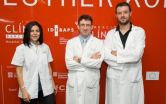(Press-News.org) Could controlling cell-membrane fat play a key role in turning off disease?
Researchers at the University of Illinois at Chicago think so, and a biosensor they've created that measures membrane lipid levels may open up new pathways to disease treatment.
Wonhwa Cho, distinguished professor of chemistry, and his coworkers engineered a way to modify proteins to fluoresce and act as sensors for lipid levels.
Their findings are reported in Nature Chemistry, online on Oct. 9.
"Lipid molecules on cell membranes can act as switches that turn on or off protein-protein interactions affecting all cellular processes, including those associated with disease," says Cho. "While the exact mechanism is still unknown, our hypothesis is that lipid molecules serve sort of like a sliding switch."
Cho said once lipid concentrations reach a certain threshold, they trigger reactions, including disease-fighting immune responses. Quantifying lipid membrane concentration in a living cell and studying its location in real time can provide a powerful tool for understanding and developing new ways to combat a range of maladies from inflammation, cancer and diabetes to metabolic diseases.
"It's not just the presence of lipid, but the number of lipid molecules that are important for turning on and off biological activity," said Cho.
While visualizing lipid molecules with fluorescent proteins isn't new, Cho's technique allows quantification by using a hybrid protein molecule that fluoresces only when it binds specific lipids. His lab worked with a lipid known as PIP2 -- an important fat molecule involved in many cellular processes. Cho's sensor binds to PIP2 and gives a clear signal that can be quantified through a fluorescent microscope.
The result is the first successful quantification of membrane lipids in a living cell in real time.
"We had to engineer the protein in such a way to make it very stable, behave well, and specifically recognizes a particular lipid," Cho said. He has been working on the technique for about a decade, overcoming technical obstacles only about three years ago.
Cho hopes now to create a tool kit of biosensors to quantify most, if not all lipids.
"We'd like to be able to measure multiple lipids, simultaneously," he said. "It would give us a snapshot of all the processes being regulated by the different lipids inside a cell."
###
Other authors on the paper are postdoctoral researcher Youngdae Yoon, who developed the sensor; Park J. Lee, a doctoral student who developed microscope tools to enable the lipid quantification; and doctoral student Svetlana Kurilova, who worked on the protein cell delivery.
New membrane lipid measuring technique may help fight disease
2011-10-10
ELSE PRESS RELEASES FROM THIS DATE:
Behind on Paying Your Tax Debt? Let Blue Tax Get Behind You to Find a Resolution
2011-10-10
Often, in this economy, it is easy to get behind. You know you owe taxes to the IRS, but every day bills and financial obligations begin to take priority in order to maintain a reasonable standard of living.
This is the situation Michael (Tecumseh, Kansas) found himself in when he called the offices of Blue Tax in desperation looking for some guidance on how to get the IRS to cease sending him threatening letters about levies and garnishments, knowing that he owed back taxes.
Michael's goal in retaining Blue Tax's services was to protect him from possible collection ...
Novel technique uses RNA interference to block inflammation
2011-10-10
Massachusetts General Hospital (MGH) researchers – along with collaborators from Massachusetts Institute of Technology (MIT) and Alnylam Pharmaceuticals – have found a way to block, in an animal model, the damaging inflammation that contributes to many disease conditions. In their report receiving early online publication in Nature Biotechnology, the investigators describe using small interfering RNA technology to silence the biochemical signals that attract a particular group of inflammatory cells to areas of tissue damage.
"The white blood cells known as monocytes ...
Smarter toxins help crops fight resistant pests
2011-10-10
One of the most successful strategies in pest control is to endow crop plants with genes from the bacterium Bacillus thuringiensis, or Bt for short, which code for proteins that kill pests attempting to eat them.
But insect pests are evolving resistance to Bt toxins, which threatens the continued success of this approach. In the current issue of Nature Biotechnology, a research team led by UA Professor Bruce Tabashnik reports the discovery that a small modification of the toxins' structure overcomes the defenses of some major pests that are resistant to the natural, ...
Aircraft Management Group Inc. Announces New Hires
2011-10-10
Aircraft Management Group, Inc., branded as AMG Jets, is pleased to announce the expansion of its team to include two new members. These members include Shannon Pennypacker, appointed as Director of Marketing and Sales; and Lynne Cone, appointed as a private aviation specialist.
This expansion is in response to the increasing demand level and sales growth last year. "We have experienced consistent growth year after year," said President John Sieckowski. "The increase in our team will help us to keep up with the growing demand of our wide range of services."
Shannon ...
Scientists discover 3 new gene faults which could increase melanoma risk by 30 percent
2011-10-10
An international team of researchers has discovered the first DNA faults linked to melanoma - the deadliest skin cancer - that are not related to hair, skin or eye colour.
Cancer Research UK scientists at the University of Leeds, together with a team from the GenoMEL consortium*, scanned the genes in blood samples from almost 3000 Europeans with melanoma, and compared these with samples taken from the general population.
Their findings are published in Nature Genetics today.**
Known risk factors for melanoma include fair skin, blue or green eyes, blond or red hair, ...
Graphene's 'Big Mac' creates next generation of chips
2011-10-10
The world's thinnest, strongest and most conductive material, discovered in 2004 at the University of Manchester by Professor Andre Geim and Professor Kostya Novoselov, has the potential to revolutionize material science.
Demonstrating the remarkable properties of graphene won the two scientists the Nobel Prize for Physics last year and Chancellor of the Exchequer George Osborne has just announced plans for a £50m graphene research hub to be set up.
Now, writing in the journal Nature Physics, the University of Manchester team have for the first time demonstrated how graphene ...
Genome-wide studies have identified new genes involved in susceptibility to melanoma
2011-10-10
The genomic analysis technologies enable the study of genetic factors related to numerous diseases. In few areas this researches brought such a big and useful volume of information as in the case of melanoma. A study published in Nature Genetics, promoted by the GenoMEL consortium, consolidates the results obtained in previous whole-genome analysis and identifies three new chromosomal regions implicated in susceptibility to melanoma. The GenoMEL consortium is funded by the European Commission and the National Institutes of Health (USA) to increase the understanding of genetic ...
If you don't snooze, do you lose?
2011-10-10
MADISON – An ongoing lack of sleep during adolescence could lead to more than dragging, foggy teens, a University of Wisconsin-Madison study suggests.
Researchers have found that short-term sleep restriction in adolescent mice prevented the balanced growth and depletion of brain synapses, connections between nerve cells where communication occurs.
"One possible implication of our study is that if you lose too much sleep during adolescence, especially chronically, there may be lasting consequences in terms of the wiring of the brain," says Dr. Chiara Cirelli, associate ...
NYU biologists use Sinatra-named fly to show how to see the blues -- and the greens
2011-10-10
New York University biologists have identified a new mechanism for regulating color vision by studying a mutant fly named after Frank ('Ol Blue Eyes) Sinatra. Their findings, which appear in the journal Nature, focus on how the visual system functions in order to preserve the fidelity of color discrimination throughout the life of an organism. They also offer new insights into how genes controlling color detection are turned on and off.
Many biologists study how different cells develop to acquire their fate. The NYU research team, headed by Claude Desplan, a professor ...
Small molecules can starve cancer cells
2011-10-10
All cells in our body have a system that can handle cellular waste and release building blocks for recycling. The underlying mechanism is called autophagy and literally means "self-eating". Many cancer cells have increased the activity of this system and the increased release of building blocks equip the cancer cells with a growth advantage and can render them resistant towards treatment.
"We have discovered a small molecule that can block autophagy in different cancer cells and specifically, this molecule can increase the sensitivity of breast cancer cells towards one ...


